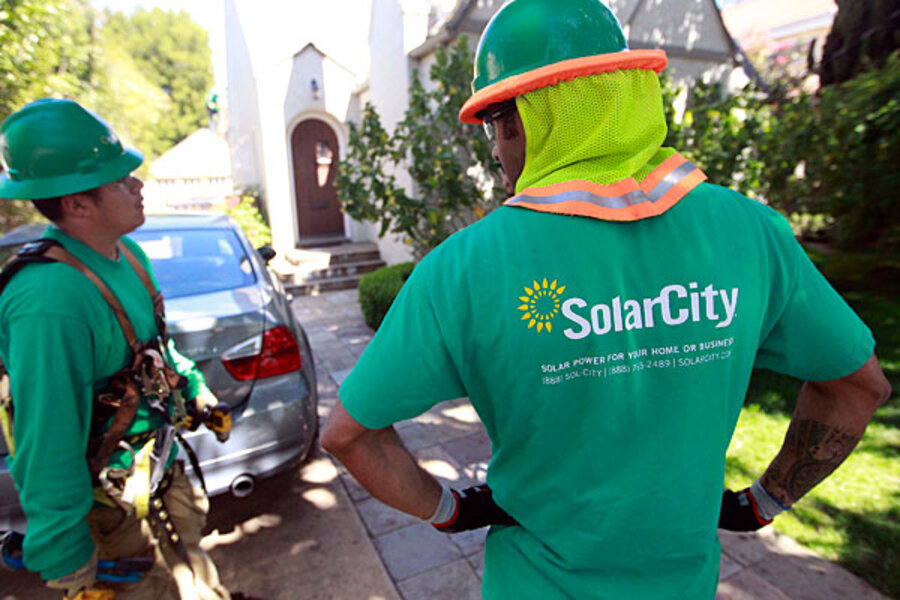Green energy: Silicon Valley leads a back-to-basics revolution
Loading...
| Mountain View, Calif.
Even before Solyndra became synonymous with the perils of the green-technology industry, the industry was changing.
Grand plans, like those of Solyndra to bring solar energy to firms nationwide, still ripple through Silicon Valley, but quietly. The current economic slump and Chinese competition have taken a toll.
Instead, a new vision for the future of the green economy is emerging – at least for the short term. Instead of transforming power grids, green companies are looking at more incremental advances, whether it's improving light-bulb efficiency or helping Wal-Mart make its supply chain more environmentally friendly.
But this more modest outlook is not a retreat, analysts say. Moreover, data suggest that the United States remains the world leader in private-sector investment in clean technology, with Silicon Valley leading the way.
"I think clean-tech industry is still a growing area for venture capital investments," says Mark Heesen, president of the National Venture Capital Association. "It is an area fraught with a lot of risks – no question about that – but there are also huge and significant game-changing technologies coming out of venture-backed clean-tech companies."
China has invested far more public money into clean-tech industry than any other country, according to Cleantech Group, a global research organization in San Francisco. But the US is still No. 1 when it comes to venture capital.
- The US accounted for 76 percent of the $2.2 billion in clean-technology venture investments across the world in the third quarter of 2011, according to Cleantech Group. The Asia Pacific accounted for 14 percent, and Europe and Israel 10 percent jointly. Within the US, California attracted 39 percent of the investments.
- California attracted 40 percent of global clean-tech venture capital in the first half of 2010, more than double what it attracted in the first half of 2009, according to the California Green Innovation Index, published by Next 10, an independent research group. Silicon Valley attracts 54 percent of clean-tech investment in the state. "The valley continues to be the hot spot for clean tech," says Noel Perry, founder of Next 10.
- California ranks first in the US in green-tech patents by a wide margin. It had 450 between 2007 and 2009, outpacing New York, which had 300.
Several experts attribute a major part of the success to the industry's strategic move to support multinational corporations in their efforts to go green.
"Green is now mainstream and should be measured in private-equity spending and growth in the green offerings of mainstream companies like General Electric and Procter & Gamble," says Terry Tamminen, author of "Lives Per Gallon: The True Cost of Our Oil Addiction."
Big companies are spending money to make their own operations greener. Wal-Mart commissioned SolarCity of San Mateo, Calif., to install solar panels on as many as 60 additional California stores this year, meaning more than 75 percent of its stores in the state would use solar energy.
But the real trends in clean tech are apparent in the entire "green" supply chain, where Wal-Mart is also a leader, Mr. Tamminen says.
"Wal-Mart is pushing everyone in its supply chain to reduce packaging, use more efficient transport systems, replace toxic chemicals with nontoxic alternatives, and secure food from local suppliers," he adds. "It's 'green' but not the typical clean-tech, Silicon Valley high-tech products and investments you typically think of when saying 'green.' "
Like corporations, cities can play a role in stimulating green technology. San Jose, Calif., signed a contract recently with SolarCity to build 28 solar sites, says SolarCity spokesman Jonathan Bass.
The developments represent a gradual evolution of business models rather than a total paradigm shift. Though the wind and solar sectors remain strong, some experts say the focus is moving away from capital-intensive and fundamentally life-altering industries to companies that yield returns in comparatively short periods.
Bridelux is a leading developer and manufacturer of LED lighting technologies in the valley and was recently named in the annual Global Cleantech 100, the top 100 innovative companies projected to make a significant market impact over the next five to 10 years.
Cypress Envirosystems helps retrofit existing commercial buildings and industrial facilities for energy efficiency and lower maintenance costs. The field is crowded, with Serious Energy, SCi, Soladigm, and Enlighted providing the same services.
"What we have seen, particularly in the last two years, is that VCs [venture capitalists] are saying, 'We are also interested in looking a lot more at short-term types of investments that are not necessarily game changers but work around the edges of clean technology,' " says Mr. Heesen of the National Venture Capital Association.
Companies in architectural designs, building material, and lighting, for instance, will have significant impacts on the amount of oil Americans use, he says. They "can make money in the shorter term, and they are not regulated as heavily."
Of course, Silicon Valley and the broader Bay Area are still thinking big. Solar Trust of Oakland, Calif., which rejected a $2.1 billion loan guarantee from the US Energy Department, has its 1,000-megawatt Blythe Project in California, which it hopes will have an output capacity comparable to large coal-fired and nuclear power plants.
But the negativity surrounding Solyndra has clouded how Silicon Valley is evolving, says Sheeraz Haji, chief executive officer of Cleantech Group.
"Within the US, Silicon Valley has a very prominent place in terms of innovation, financing, and the enormous presence of venture capitalists," he says. "Silicon Valley is going to continue leading the country in the clean-tech field."





